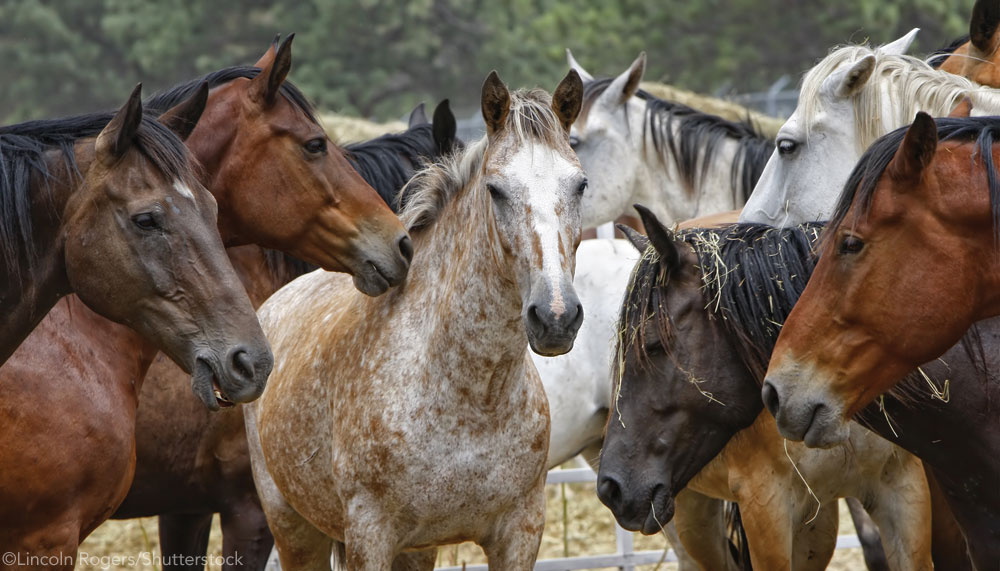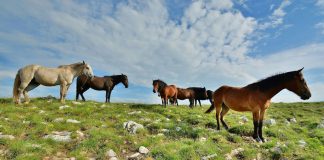
Horses seek out other horses because of their gregarious nature. They want to be together and to be part of a herd. All horses are herd bound. It may be inconvenient to us as riders, but being drawn to the herd is a natural equine behavior.
Why the Herd?
Horses rely on the herd for safety. A horse can rely on others to keep watch so he can rest; they take turns resting and watching.
Horses also get comfort from the herd. Horses want to lie down in the sun with others and be taken care of and groomed. They want a strong leader. All of this comfort comes from being part of a larger group.
Horses believe that their own survival depends on being accepted into a herd. When you introduce a new horse into the herd, they will first send him away and be mean. The new horse will keep coming back because he feels as if he will die if he’s not part of the herd.
The horse is programmed to seek out acceptance from the herd. When you can get that same kind of seeking acceptance aimed toward you, you can have amazing, bonded relationships with horses.
Left Behind
When you separate two buddies, the horses can be worried and act out. Because they are programmed to be part of the herd, they believe they are in jeopardy if they are left behind. This panic can be worse if two bonded horses (who are used to being together all the time) are separated because you want to work with one and not the other.
Consider the herd dynamics. Keep in mind that within a large herd, there’s one horse in charge and one horse at the bottom of the pecking order. There are also sub-relationships between bonded horses.
If a herd is large, horses will have one or two buddies, technically called associates, that he hangs out with most often. If your horse is turned out in a large group at a boarding barn, you’ll easily see who your horse’s buddies are. He’ll only mutual-groom with another horse if they have a bonded relationship.
If you get one horse out to ride and leave the buddy horse at the barn, the horse left behind may run up and down the fenceline, whinny frequently, cause commotion and even injure himself. It’s most often the horse that is left behind who causes a problem, not the horse who you’ve chosen to work with first.
What to Do: If I’m trying to work with one horse while another horse is in such a panic, I’d want to secure that horse to lessen his panic and to keep him from distracting the horse I’m working with. If the horse left behind is a trained horse, I’ll take him from the pen and tie him up at a sturdy hitching post.
He may still be upset, but he can’t run up and down the fence (which increases his panic). In most instances when you tie the horse, he’ll eventually revert to what he knows how to do—stand quietly when tied.
If the horse is not trained to stand tied, he needs to learn the skill. Make sure to tie him safely in a strong halter and with a quick release knot or with a clip that is designed to release if the horse panics.
Have a friend stay near the tied horse so that there’s help if he pulls back or gets in trouble. A horse that is frantic may panic and pull back to get to his buddy. Put him in a safe and comfortable place to stand tied—don’t leave him in the hot sun or standing on concrete.
Horses should be trained to tie and should be tied regularly, so that they know how to stand tied when it’s required. Tying is a skill that must be trained to the horse, and for some horses it may require regular practice.
If he isn’t accustomed to standing tied, make sure that he is in a confined area without any sharp edges, protrusions or areas where he could get caught or hit his head if he rears.
The Distracted Horse
If the buddy horse that you’re riding is pulling to the gate and toward his friend at the barn, correct him. That is disobedient behavior and you should acknowledge it as such.
Just steering him away and acting as if nothing ever happened makes him think you didn’t notice his disobedience, so he does it again and again. Your horse should not be allowed to look out at his friends or slow down at the gate.
What to Do: Over time, if you allow a horse to glance at the barn, look at his buddies, or pull toward the gate, the behaviors will escalate. Soon, you’ll have a horse that stops at the gate and won’t move. Or you’ll have a horse that won’t walk a straight line, but instead pulls away from the direction you’re riding. Soon, he’ll be the one deciding where to go and how fast to get there—perhaps galloping back to the barn.
If you correct these little behaviors—even a slight glance away—by scolding your horse or lightly bumping with your outside leg and inside rein and pushing him forward, he’ll soon learn that he must focus on his work and not his buddy.
Build in some time to make sure that you separate buddy horses on purpose. Let them know that they may not always be together, and if they are separated they will still be safe.
Put one horse in another pen as practice before you need to separate the horses for the farrier or veterinarian visit. If you have a plan and practice, your horses will trust that they are safe—even when separated.
JULIE GOODNIGHT shares her lessons on her RFD-TV show, Horse Master (also online at tv.juliegoodnight.com), and through clinics and expos. HEIDI MELOCCO (www.whole-picture.com) is a lifelong horsewoman, equine journalist, and photographer.
This article originally appeared in the August 2017 issue of Horse Illustrated magazine. Click here to subscribe!





